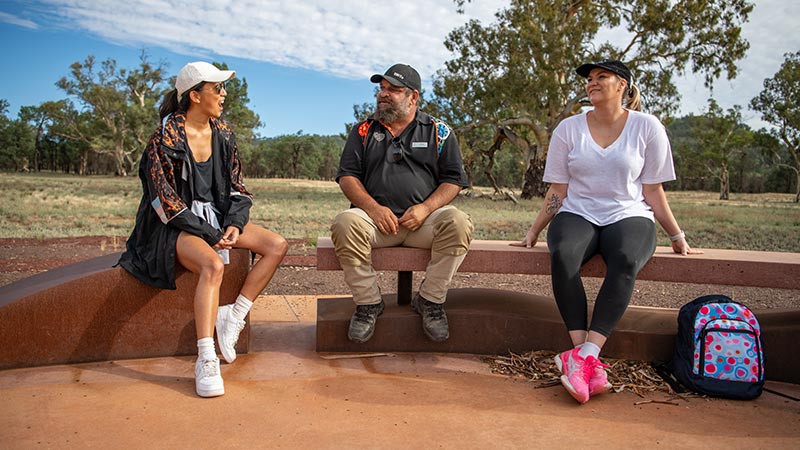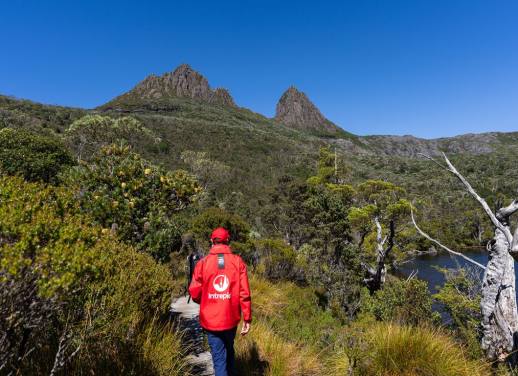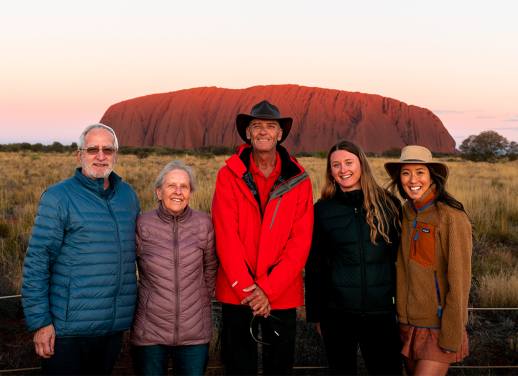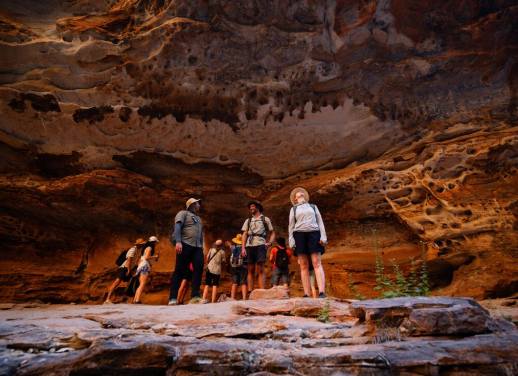Set in the heart of South Australia’s Ikara-Flinders Ranges National Park, Wilpena Pound is a stunning natural amphitheatre and an award-winning public art space. It’s a sacred place for the Adnyamathanha people, and as Tiana Templeman discovers, it’s the perfect spot to connect with Country.
Adnyamathanha guide Vince Coulthard’s father, Clem Coulthard, always said, “How can we expect Udnyu [‘white people’, in the local language] to understand us if we don’t share our culture?” Clem was head ranger at Ikara-Flinders Ranges National Park in the 1980s. He was passionate about Country, and when Vince grew up, he decided to follow in his father footsteps. He’s been guiding on this Land since 2018.
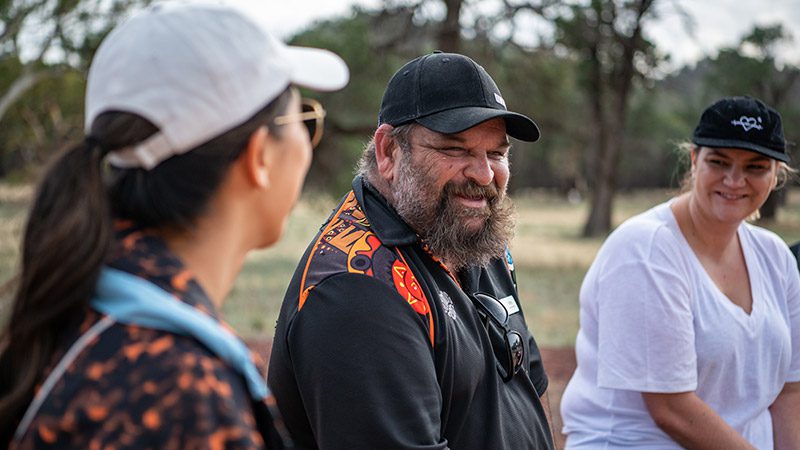
Our Intrepid group has come to Ikara (Wilpena Pound) to join him on a guided walk that shines a light on Adnyamathanha history, which stretches back thousands of years, and share stories about the park’s more recent past. Learning about Country and the culture of this place with a Traditional Custodian is a rewarding and tangible way to support Australia’s reconciliation journey. It’s one of three First Nations tours included on our seven-day Intrepid Flinders Ranges Explorer trip.
The dramatic mountains and rugged peaks that make up Ikara stretch 17 kilometres across the russet landscape at Ikara-Flinders Ranges National Park. Together, they create a curve which forms a natural ‘pound’ or enclosure, eight kilometres wide. In the Adnyamathanha language, the name Ikara means meeting place, and it continues to be a destination where people can come together and share stories.
We set off with Vince, who leads us across his people’s Land and towards the distant collection of farm buildings known as Old Wilpena Station. White settlers were first seen by First Nations Custodians of the Flinders Ranges in the 1840s, and they certainly made an impression.
“When the white fellas turned up, our people thought they were ghosts,” says Vince.
He explains that when Adnyamathanha people died, they were covered in white clay as part of a traditional burial ceremony. As the Europeans made their way across the landscape, it appeared as if the spirits of the First Nations Custodians of Ikara had returned and were walking the earth.
As history shows, this wasn’t the only reason the Adnyamathanha had to be concerned about the arrival of European settlers. It didn’t take long for the pastoralists to claim areas with easy access to water for themselves and their stock. The Adnyamathanha were kept away from these and other natural resources and retaliated by stealing sheep, something that did not go unpunished by the settlers.
Farming also took a toll on Adnyamathanha Land, which were no longer being managed in traditional ways. As we get closer to Old Wilpena Station, Vince explains it will take centuries for the area to regenerate after being farmed.
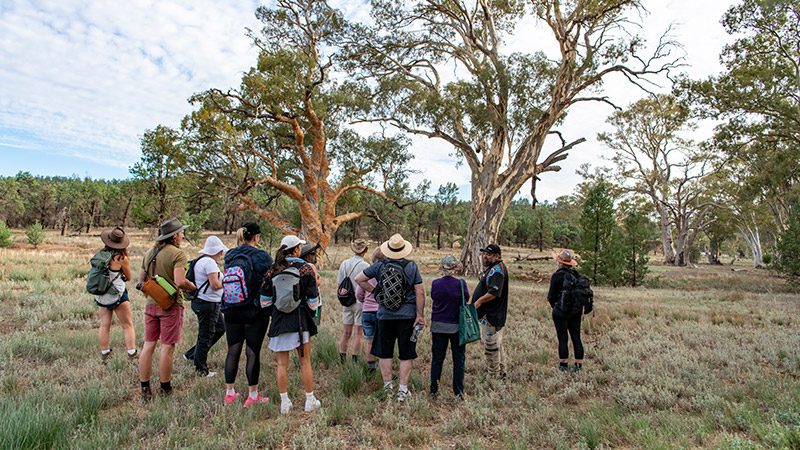
As Australia continues working towards reconciliation and strengthening relationships between Aboriginal and Torres Strait Islander peoples and non-Indigenous peoples, the number of First Nations-run tours on Intrepid trips have increased to support this journey. Like many of these experiences, our Ikara tour includes the history of the Traditional Owners and those who came after them, and also looks to the future. It’s an approach that sits well with Vince Coulthard.
“Aboriginal culture is all about sharing and it’s about the stories. What happened needs to be acknowledged and then we can move on,” he says. “We can’t undo the past. It needs to be acknowledged or we can’t move forward.”
In 2009, the Adnyamathanha people were recognised as the Traditional Owners of Wilpena Pound and the Flinders Ranges region. They have been jointly managing Ikara-Flinders Ranges National Park with the South Australian Government since 2011. They also own Wilpena Pound Resort, which provides a viable way for Adnyamathanha people to work in the area and stay on Country.
“Aboriginal culture is all about sharing and it’s about the stories. What happened needs to be acknowledged and then we can move on.”
Vince Coulthard
As we make our way across the landscape, Vince points out hollow trees that Adnyamathanha mothers and babies once used for shelter, and the best spots to find acacia seeds to make damper. We’re tramping in the footsteps of Sir Douglas Mawson, who devoted much of his life to researching the region. Mawson was a geologist and lecturer at the University of Adelaide prior to becoming an Antarctic explorer. Even when he should have been acclimatising in preparation for upcoming expeditions in subzero temperatures, he couldn’t resist the pull of this incredible place.
When we reach the collection of buildings at Old Wilpena Station, our group settles down on a seat at a spot known as The Meeting Place, which is also an award-winning public art space. Vince explains Adnyamathanha is made up of two different words: adnya, meaning rock, and mathanya, meaning people, and there are creation stories all around us. He gestures towards the surrounding mountains and points out Ngarri Mudlanha (St Mary Peak) shimmering in the distance.
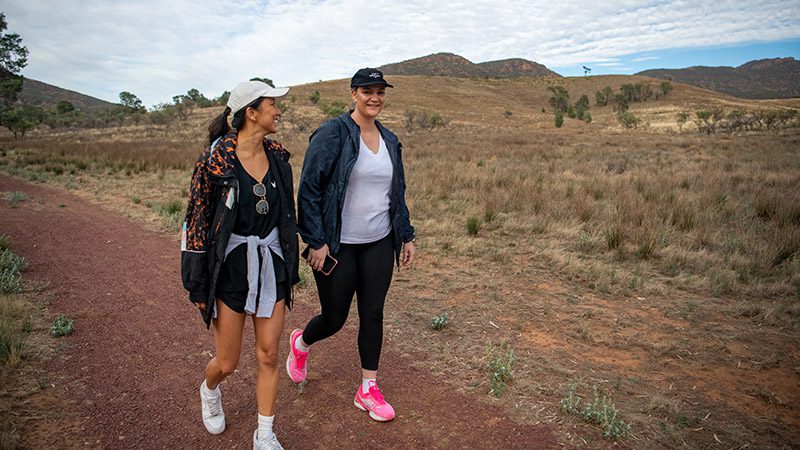
Ngarri Mudlanha is the highest point in the Flinders Ranges and the Adnyamathanha believe it is the head of a giant Akurra (serpent) who played a key role in the creation story of Ikara. Late one night, while everyone was at a corroboree, two mighty Akurra (serpents) prepared to attack. Yurlu, the Kingfisher Man, saw the danger but it was too late. Only Yurlu and Walha the Wild Turkey Man managed to escape. However, the two serpents paid the ultimate price for their greedy ambush. The Akurra were so full they could no longer move and died where they lay, with their bodies forming the walls of the pound. Look closely when you’re out walking, says Vince, and you’ll see rocks that appear to be imprinted with rows of giant scales.
On our way back to the visitor centre, turquoise mulga parrots flit through 500 year-old trees, creating splashes of colour against a landscape that’s rich with stories and history. Ikara is 300 metres higher than Uluru, and arguably just as culturally significant, but none of our group realised the impact this sacred place would have on us.
That afternoon, we find some of the scaly rocks that Vince was talking about and are reminded of the two mighty Akurra serpents. It’s amazing what you can see when your eyes – and your heart, mind, and soul – are opened to the natural wonders around you.
Want to explore Wilpena Pound yourself? Check out our 7-day Flinders Ranges Explorer trip.

